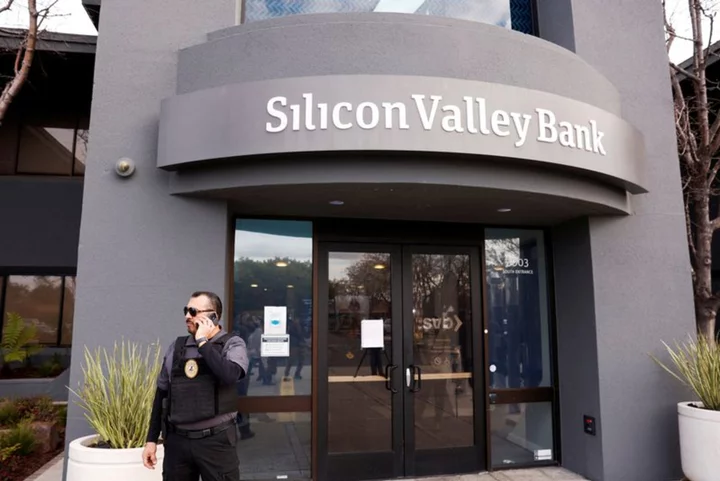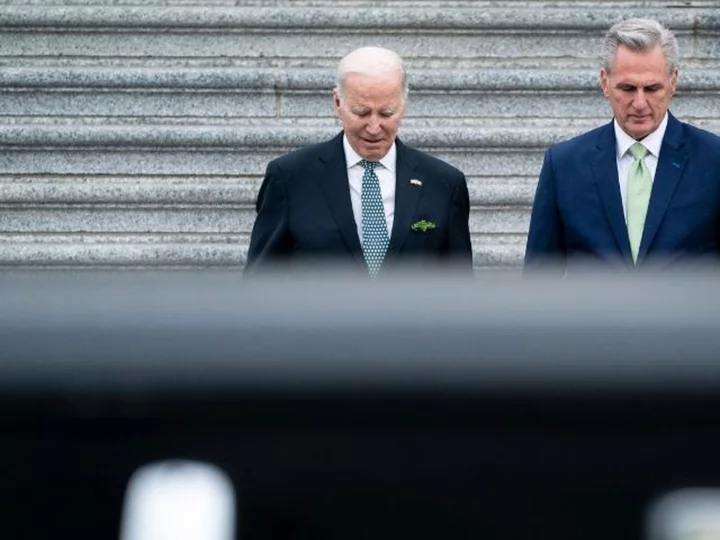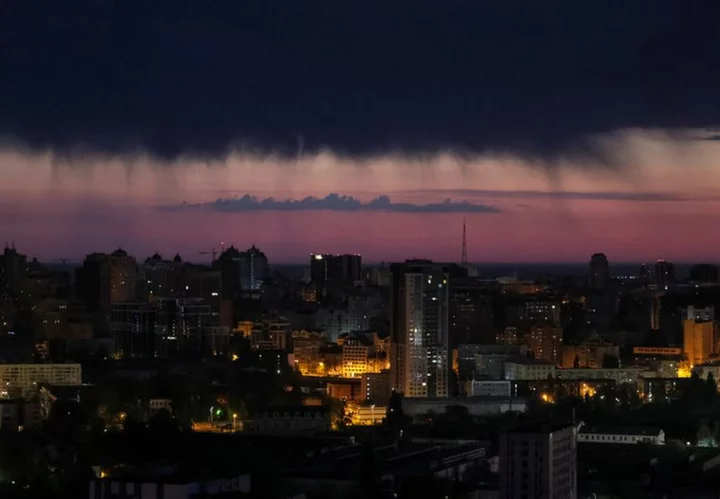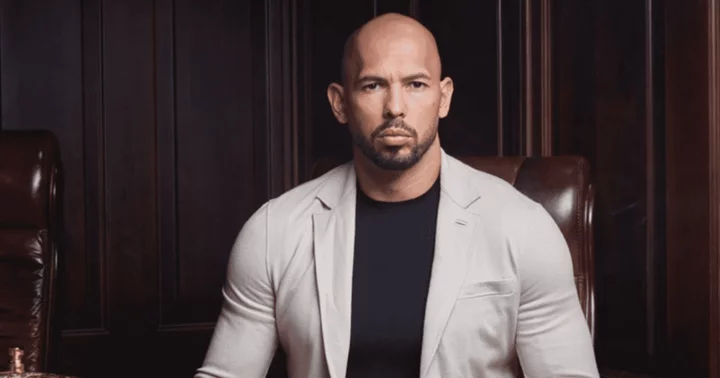By Ann Saphir
The lightning-fast collapse of Silicon Valley Bank this spring laid bare an inconvenient truth: Some U.S. banks are not prepared to borrow from the Federal Reserve if they need to, and a Reuters analysis shows that problem is most acute among the nation's smallest banks.
SVB, a top-20 bank with over $210 billion in assets at the time it failed, had an insufficient stash of collateral and in the year before it went down had not tested its access to the "discount window" through which the Fed doles out emergency loans. That "lack of preparedness may have contributed to the speed of SVB's demise," the Fed said in a review of the collapse published in April.
It's a vulnerability that has come into stark relief since SVB's failure unleashed record demand for emergency credit from the Fed, raising concerns at both headquarters in Washington and across the 12 Fed districts stretched across the country.
Fed Chair Jerome Powell last Wednesday acknowledged that the banking stress earlier this year revealed that using the discount window "can be a little bit clunky."
"So why not be in a situation where you're just much more ready in case you...need to access this discount window?" he said in news conference after the central bank's policy meeting.
Indeed, the Fed and other bank regulators amplified that message on Friday with updated guidance saying "the agencies encourage depository institutions to incorporate the discount window as part of their contingency funding arrangements" and banks should maintain "operational readiness" to tap into it in a pinch.
An analysis of Fed data by Reuters, though, shows a lot still needs to be done to meet that goal.
While California-based SVB was unusual among its peers -- a majority of banks with $100 billion or more in assets have run frequent tests of their discount-window access -- many smaller ones have not and may not be prepared to borrow at all, the data suggests.
"I was very, very surprised. I’ve been involved in monetary policy implementation for over two decades, and I was surprised by this most recent banking stress, the number of banks that are not fully set up for the discount window," Dallas Fed President Lorie Logan said in July.
Every bank in Texas and in the nation should establish access and "test the plumbing," she said.
MISSION CRITICAL
For all the focus the Fed draws for its center-stage role in setting interest rates for the U.S. and beyond, its most critical mission is far more basic: Lend when no one else will.
Created in the early 20th century to bring a halt to the cycles of bank panics that had crippled the economy with alarming frequency since the birth of the republic, the Fed has a virtually boundless capacity to provide credit to banks in moments of crisis and thus ensure the wider stability of the financial system.
There's a catch, of course. Banks must be willing to ask for that lifeline in their hour of need, and they have to be set up to do so. While borrowing at the Fed may sound simple, it does require filing the paperwork, posting the collateral and, ideally, conducting regular test runs.
The Fed won't reveal which banks, or even how many, have done the work to gain access, a process that it has said can take weeks. But central bank data shows there are many banks which have not stepped up to the discount window, either to borrow money for real need, or to test it.
SIZE MATTERS
In general, the smaller the bank, the less likely it has dipped into the discount window.
From July 2010 to June 2021, nearly all banks with more than $50 billion in assets, and about 70% of banks with $1 billion or more in assets, borrowed at least once from the discount window, either in small amounts that suggest a test, or in larger amounts that point to actual need.
But only about 40% of the approximately 1,800 banks with between $250 million and $1 billion in assets in communities across the nation touched the discount window during that time, the data shows.
In Logan's district - Texas and parts of New Mexico and Louisiana - the figure for such small banks was about 20%.
For the tiniest banks, those with less than $250 million in assets, less than a fifth nationwide had tapped the window.
The data records details on more than 40,000 transactions, from thousands of $1,000 test loans to the $5 billion Goldman Sachs borrowed during the COVID-19 government-mandated shutdowns in 2020.
All told, about 3,800 banks borrowed from the discount window during the 11-year period detailed in the central bank data. That's just over 40% of the more than 9,000 depository institutions, including credit unions and branches of foreign banks, currently entitled to borrow from the Fed.
There are limits to what the data tells us.
It doesn't include banks that filed the proper paperwork, and even posted collateral, but for whatever reason did not try out the discount window during that time frame.
And it doesn't capture any banks that have newly set up access or tested since 2021, and particularly since SVB's collapse in March focused fresh attention on the need for liquidity. The Fed publishes discount window transactions two years after the fact.
Even so, says Richmond Fed economist Huberto Ennis, based on the data "it seems safe to assume a meaningful proportion of banks still did not have ready access to the discount window, at least until recently."
Reuters reached out to the 10 biggest banks with no public record of borrowing from the discount window. Most of them indicate in public filings that they have pledged collateral at the Fed. Several told Reuters they had tested their access, without specifying a date. One said its test took place prior to 2010.
The National Credit Union Association requires members with $250 million or more in assets to have discount window or other emergency liquidity access. Only 1,100 of its 4,700 members meet that threshold. But some 1,366 were signed up to use the discount window as of December, the NCUA said.
Banks are not subject to any such requirement, and the Fed declined to provide a count of those with access. But Fed Governor Michelle Bowman said in May that "a number" of banks had not registered.
VeraBank, a $4.5 billion bank in Henderson, Texas, has done testing for years: each July it borrows $100,000 from the Fed, and repays it the next day, the data shows.
"I think you should always have the access -- you just never know," CEO Brad Tidwell says. "If you are not testing it with some regularity, I don’t know how you can assure yourself that it’s going to be there if you need it."
Among the biggest banks -- there are 33 currently with more than $100 billion in assets -- regular testing is not universal. Just over half tapped the discount window on a quarterly or yearly basis during the 11 years of data examined, generally in amounts of $1 million or less that suggests they were tests. Others ran less-frequent tests, and seven borrowed just once or not at all.
SVB went to the window just one time, borrowing $200 million for a day in August 2018.
PRUDENT PLANNING
For much of its history, the Fed actively discouraged banks from discount-window borrowing, requiring them for example to exhaust other funding sources first, or, more recently, by charging above-market interest rates.
When the COVID-19 pandemic hit, the Fed reversed course. It slashed that so-called penalty rate, and joined with other bank regulators to encourage banks to borrow as part of broader efforts to stave off market and credit dislocation. The biggest banks also stepped up to borrow so as to reduce discount window stigma.
After the SVB collapse this past March set off a new round of market turmoil, the Fed expanded its emergency lending further, opening a new one-year lending facility that unlike the long-established window does not impose a "discount" on pledged collateral but instead lends at the security's full face-value.
And now it and other regulators are officially encouraging banks to sign up and test at the window, part of what Chicago Fed President Austan Goolsbee told Reuters is a "big push to try to get operational readiness, of everyone that we can."
A recent "Ask the Fed" webinar for bank executives included detailed guidance on onboarding for its emergency-lending facilities, and offered assurances that establishing and testing access would be seen by supervisors as prudent planning rather than as a red flag signaling liquidity concerns.
Richmond Fed's Ennis says not all small banks actually need access. They may keep large stashes of cash on hand, or have a correspondent relationship with a bigger bank. Most banks are members of their local Federal Home Loan Bank, sometimes called the nation's lender of second-last resort, where they can call on liquidity in a pinch.
But his research suggests that banks with riskier, less-liquid books may find themselves in need of the discount window in times of financial market stress.
Minneapolis Fed President Neel Kashkari said small banks should think of the discount window as a backup.
"We point out, hey, there might come a time when the Home Loan Bank isn't able to meet your needs," he told Reuters in May. "It's an ongoing discussion. I mean, banks historically always think they're fine, until they are not."
(Reporting by Ann Saphir; Additional reporting by Michael S. Derby; Editing by Andrea Ricci)









